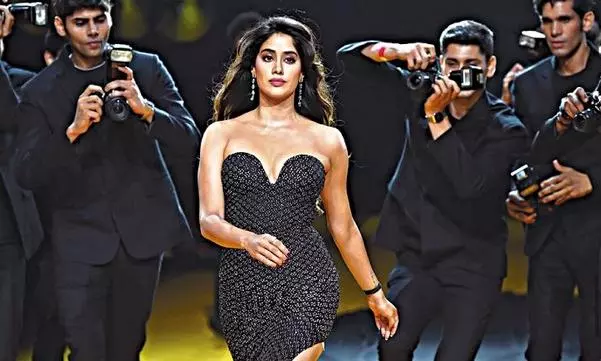Starlight Outshines Fashion on Runways
Fashion weeks are turning into star-studded showstopper events, with blatant PR for forthcoming films and brand promos

Although fashion week is over, one can’t help but gawk over the designer dresses and the dazzling pop-culture moment — and B-town stars at its heart. Gone are the days when runways were simply platforms for designers to showcase their creative work and silhouettes. Today fashion week is considered a star-studded event— even a PR moment to promote an upcoming film or a brand.
From Lakmé Fashion Week to India Couture Week, these shows have officially been termed as ‘The Red Carpet’ event. Front row seats, viral moments, and a glimpse of those diva walks. However, it was not always the same, Bollywood has now become a trend consumer engine where often brand building takes place on the ramp and not fashion.
At the recent Lakmé Fashion Week 2025, Jahnvi Kapoor didn’t simply walk the ramp— she arrived on the scene.
A glossy vintage car rolled onto the runway with paparazzi-style flashes going off, following her as she stepped out. Draped in a dramatic black trench-trail coat, she slowly removed it to reveal a jewel-toned, figure-hugging couture dress. Then came the ‘’horse walk’’: a stylised gait, with strong stomps and deliberate posture that screamed theatre over tailoring — It was high drama. Viral within minutes, designed for social media. “Although I'm a huge fan of celebs, I feel that they should leave the ramp for the models— they do it A LOT better,” says Bertille Fernades, a student.
Fashion Week’s New Lingo
During the mid-2000s, stars like Sushmita Sen or Bipasha Basu walked the ramp in elegant saris, anarkalis and chic creations with grace. It was an effortless fusion of fame and fashion. Fast forward to 2025, from Kiara Advani to Ananya Panday, every Bollywood celeb is a showstopper today. Their entry is marked with backstage smoke machines, LED screens, and camera crews on the runway as a performance. The focus? Celebrity, not much of fashion! “The performance aspect of fashion shows has significantly influenced how people perceive quality,” says Abhinav Kumar, Co-founder and CEO of Brand Concepts Limited, which frequently participates in accessories-driven fashion events. “Storytelling and immersive experiences now add emotional value to a brand.”
Cinemascope Appeal
Runways today resemble a cinematic setting vis-à-vis earlier days, where the focus was on the striking silhouettes and supermodels. Now the page has turned to neon-lit dance floors, floating platforms, big psychedelic backdrops, dreamy gardens. Fashion Week is no longer just about clothes, it’s the visual gimmicks, and star attraction. Shailina Parti, COO-Westside, adds, ‘’Bollywood fashion is very influential in the Indian consumer market, so we make it a point to encompass the trends, colour palettes and silhouettes into our design.’’
When celebs wear an outfit– they don’t just tell a story, they sell it to you. “When a celebrity steps out in the shoes of a particular brand, it helps more people discover the brand,” says Laksheeta Govil, Founder and Creative Director of Fizzy Goblet.
Designers, stylists, and brands know that tapping Bollywood isn’t just about visibility — it’s about vibe. And fans copy-paste vibes. For instance, if a celebrity is spotted in a certain style or colour, there is often a spike in interest for similar designs on website and in stores. “Celebrities bring unmatched attention, but if it’s only about surface-level glam, it can easily dilute the message,” says Amar Nagaram, Co-Founder and CEO of VIRGIO.
Models vs Actors
That balance, which was once maintained in the early 2000’s is no longer there, now there is a fight between spectacle and substance. The showstopper glam might buy designers a great deal of orders, Likes, and Million views, but it begs the question: What about the models? Super models were once the faces and forces of fashion week, who knew the walk, the attitude, and most importantly, the graceful timing. There is a certain craft with every step in a way that most celebrities, understandably, can’t replicate. “International brands, in contrast, focus on global consistency and integrate endorsements into broader, diverse strategies. However, with social media’s rise, both now prioritize authenticity and digital engagement in celebrity partnerships,” explains Kumar.
Walk The Talk
The Indian runway has always been a spectacle of aspiration. The storytelling has now become performative. We once admired craftsmanship, but now we only speak about showstopper actors. “There’s been a convergence of entertainment, fashion, and content. Earlier, runway shows were insider events, now, they’re public spectacles, made for Instagram, reels, and media buzz. The rise of celebrity stylists, fashion-focused creators, and streaming culture has blurred the lines between red carpets and ramps. It’s no longer just about buyers and editors —it’s about engagement, virality, and narrative-building,” says Nagaram. The classic model catwalk is fluid, rhythmic, and focused — because it’s not the model that’s supposed to shine– it’s the outfit. Models are trained to walk in a straight line, arms gently swaying, and posture upright with their gaze fixed. The model becomes a moving canvas, letting the construction, fabric, flow, and credit go to the designer.
The horse walk, often adopted by celebrities who haven’t had runway training, tends to be exaggerated and assertive — more about presence than polish. ‘’It’s performative, dramatic, and intended to leave an impression, but it often shifts focus away from the garment and onto the wearer,” says model Jia Rathod.
Bollywood may have brought the spectacle to the runway, but it’s the designers and brands who bring it to the people.

